Wooden Flooring Cost Estimator
Wooden flooring is a timeless and elegant choice that adds warmth, beauty, and value to any space. Whether used in residential homes or commercial spaces, wooden floors are known for their durability, versatility, and classic appeal. Accurate cost estimation is crucial for any wooden flooring installation project to ensure it stays within budget and meets all design and functional requirements. Estimate Florida Consulting provides expert cost estimator services to help you plan and execute your wooden flooring project with precision and efficiency.
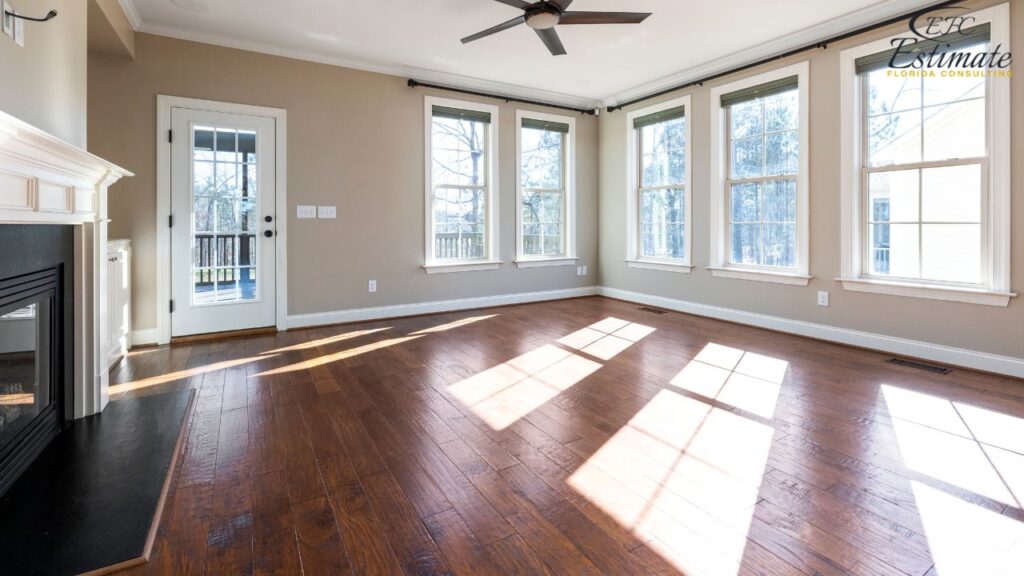
Why Choose Wooden Flooring? Key Benefits and Practical Applications
Wooden flooring is known for its aesthetic appeal and practical benefits, making it a popular option for a variety of settings. Here’s why hardwood flooring might be the perfect choice for your home.
The Timeless Appeal of Hardwood Floors
Wooden floors offer a classic and timeless look that enhances the aesthetic of any room. The natural grain patterns and rich tones of hardwood add warmth and character, making them a focal point in your home’s design. Whether you prefer a modern, rustic, or traditional style, wooden flooring can seamlessly complement various decor themes, adding elegance and sophistication to your space.
Durability and Longevity:
One of the standout features of hardwood floors is their durability and longevity. Hardwood flooring is built to last, withstanding heavy foot traffic and daily wear. It’s an excellent choice for high-traffic areas like living rooms, hallways, and kitchens. With proper care, hardwood floors can last for decades, and they can be sanded and refinished multiple times to restore their original beauty. This long-lasting quality makes wooden flooring a smart investment that adds value to your home.
Easy Maintenance:
Maintaining hardwood floors is straightforward and simple. Unlike carpets, which can trap dirt and allergens, hardwood floors are easy to clean. Regular sweeping or vacuuming and occasional mopping are usually all that’s needed to keep them looking pristine. Spills and stains can be easily wiped away, making wooden flooring a practical choice for households with children or pets. The low-maintenance nature of hardwood floors ensures that they continue to look beautiful with minimal effort.
Increasing Your Home’s Value with Hardwood Flooring
Installing hardwood floors is a surefire way to increase the value of your home. Potential buyers often see wooden flooring as a desirable feature, making your property more attractive and potentially easier to sell. The classic appeal and durability of hardwood add a premium feel to your home, which can significantly boost its market value. Investing in hardwood floors is not just about enhancing your living space; it’s also about making a wise financial decision that will pay off in the long run.
Eco-Friendly Flooring:
Many hardwood flooring options are sourced from sustainably managed forests, making them an environmentally friendly choice. Additionally, wood is a natural and renewable resource that can be recycled or repurposed at the end of its life, reducing its environmental impact. Choosing eco-friendly wooden flooring is a responsible decision that benefits both your home and the planet. By opting for sustainable wood, you contribute to conservation efforts while enjoying the beauty and warmth that hardwood floors bring to your living space.
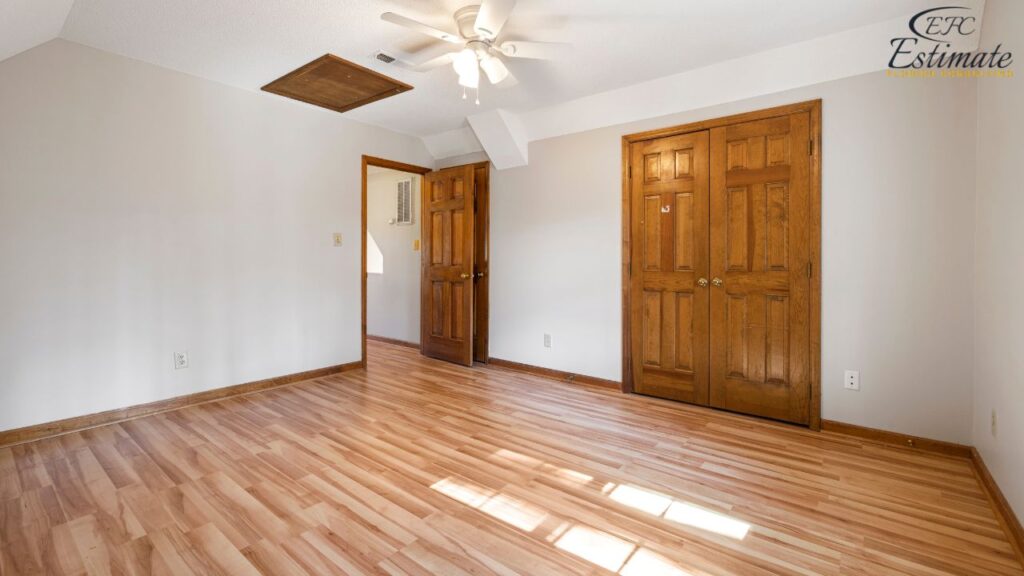
Factors That Influence Pricing
The cost of wooden flooring can vary widely depending on several factors, including the type of wood, the quality of the material, the installation process, and any additional treatments or finishes. Understanding these factors will help you estimate the total cost of your flooring project and make informed decisions that align with your budget.
Choosing the Right Wood: Types of Wooden Flooring and Their Costs
Wooden flooring comes in various types, each with its own cost range depending on the species, grade, and finish. The type of wood you choose will have a significant impact on the overall cost of your project, so it’s important to select a wood that meets both your aesthetic and functional needs.
Wood Type | Average Cost per Sq.Ft. |
Oak | $5.20 – $10.40 |
Maple | $6.50 – $13.00 |
Cherry | $7.80 – $15.60 |
Walnut | $8.45 – $16.90 |
Hickory | $7.15 – $14.30 |
Bamboo | $4.55 – $9.10 |
Oak Flooring:
Oak is one of the most popular choices for wooden flooring due to its durability, attractive grain, and affordability. Available in both red and white varieties, oak offers a distinct look that ranges from $5.20 to $10.40 per square foot. Oak’s versatility allows it to blend seamlessly with various interior styles, making it a timeless choice for any home. Its durability makes it suitable for high-traffic areas, ensuring that your floors will look great for years to come.
Maple Flooring:
Known for its light color and smooth grain, maple is a great choice for those seeking a clean and modern look. It’s harder than oak, making it more resistant to scratches and dents. Maple flooring costs range from $6.50 to $13.00 per square foot, and its subtle grain pattern adds a touch of elegance to any room. Maple’s light tone can brighten up spaces, making it an excellent choice for smaller rooms or areas that receive less natural light.
Cherry Flooring:
Cherry wood is prized for its rich, warm tones and fine grain. It’s slightly softer than oak and maple, so it may show wear more quickly in high-traffic areas. Cherry flooring costs range from $7.80 to $15.60 per square foot.
Despite being on the higher end of the price spectrum, cherry wood’s luxurious appearance makes it a popular choice for living rooms and bedrooms, where its beauty can truly shine.
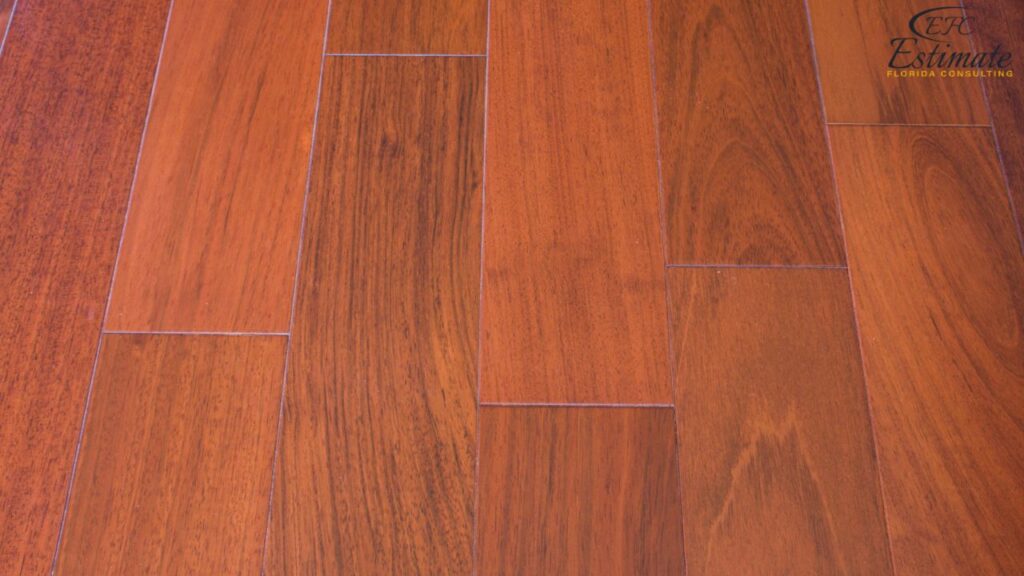
Walnut Flooring:
Walnut is a dark, rich wood known for its deep color and intricate grain patterns. It’s a softer wood, making it more suitable for low-traffic areas or rooms where a luxurious aesthetic is desired. Walnut flooring costs range from $8.45 to $16.90 per square foot. Its distinctive appearance and premium feel make it a top choice for formal spaces such as dining rooms or studies.
Hickory Flooring:
Hickory is one of the hardest domestic woods, making it extremely durable and resistant to wear. It has a distinctive grain pattern and color variation, which adds character to any space. Hickory flooring costs range from $7.15 to $14.30 per square foot. Its rugged durability makes it ideal for high-traffic areas, while its unique look adds a touch of rustic charm.
Bamboo Flooring:
Although technically a grass, bamboo is often grouped with hardwoods due to its similar properties. It’s eco-friendly, durable, and offers a contemporary look with its straight grain and uniform color. Bamboo flooring costs range from $4.55 to $9.10 per square foot, making it an affordable and sustainable option. Bamboo is particularly well-suited for modern and minimalist interiors, where its sleek appearance can complement the overall design.
Quality and Grade: How the Wood's Grade Impacts Cost
The quality and grade of the wood you choose will also impact the overall cost. Higher-grade wood tends to have fewer knots and imperfections, resulting in a more uniform appearance. However, these higher grades come at a premium price. On the other hand, lower-grade wood may have more character and natural variations, which some homeowners find appealing.
Wood Grade | Average Cost per Sq.Ft. |
Clear Grade | $8.45 – $16.90 |
Select Grade | $6.50 – $13.00 |
Common Grade | $5.20 – $10.40 |
Rustic Grade | $4.55 – $9.10 |
Clear Grade:
This is the highest grade of wood flooring, featuring a uniform appearance with minimal knots and color variations. Clear grade wood is the most expensive, with costs ranging from $8.45 to $16.90 per square foot. This grade is ideal for homeowners seeking a flawless, high-end look in their flooring, making it a great choice for formal living spaces and luxury homes.
Select Grade:
Select grade wood has a more consistent appearance than common grades but may include slight variations in color and grain. It’s a good balance between quality and cost, with prices ranging from $6.50 to $13.00 per square foot. Select grade wood is popular for homeowners who want a refined look without the premium price of clear grade.
Common Grade:
Common grade wood includes more natural variations such as knots, mineral streaks, and color differences. These features give the wood character and a more rustic look. Common grade wood is more affordable, with costs ranging from $5.20 to $10.40 per square foot. This grade is perfect for those who appreciate the natural beauty and uniqueness of wood, making it ideal for casual and rustic settings.
Rustic Grade:
Rustic grade wood, sometimes called cabin grade, features significant variations, including larger knots, cracks, and color changes. It’s the most affordable option, with costs ranging from $4.55 to $9.10 per square foot. Rustic grade wood is ideal for spaces where a rugged, natural look is desired, such as cabins, country homes, or industrial-style interiors.
Installation Costs: DIY vs. Professional Installation
The complexity of installing wooden flooring will significantly impact the overall cost. While some homeowners may choose to install the flooring themselves, professional installation ensures a flawless finish and can save time and potential headaches. Understanding the pros and cons of DIY versus professional installation will help you decide the best approach for your project.
Installation Type | Labor Cost per Sq.Ft. |
DIY Installation | $1.95 – $4.55 |
Professional Installation | $3.90 – $7.80 |
DIY Installation:
For those with some DIY experience, installing wooden flooring can be a rewarding project. The labor cost for DIY installation typically ranges from $1.95 to $4.55 per square foot, depending on the complexity of the installation and the tools required. While this approach can save money, it requires careful preparation and precision to achieve a professional-looking result, especially in larger or more intricate areas. DIY installation is best suited for those who are confident in their abilities and have the necessary tools and time to dedicate to the project.
Professional Installation:
Hiring a professional installer is often the best choice for those who want to ensure a perfect finish and avoid the potential pitfalls of DIY installation. The labor cost for professional installation ranges from $3.90 to $7.80 per square foot, depending on the type of wood, the complexity of the installation, and the region. Professional installation includes subfloor preparation, precise cutting, and seamless installation, ensuring that your flooring is installed correctly and will last for years. While the upfront cost is higher, professional installation can save you time and ensure that your flooring is installed to the highest standards, reducing the risk of issues down the line.
Additional Costs and Considerations: What Else to Budget For?
When planning your wooden flooring project, it’s important to consider additional costs that may arise, such as subfloor preparation, moisture barriers, and finishing treatments. These factors are crucial for ensuring a long-lasting and durable floor, and they should be included in your overall budget. Properly accounting for these additional costs can help you avoid surprises and ensure that your project stays on track both financially and in terms of timing.
Subfloor Preparation:
The condition of your subfloor is a key factor in the success of your wooden flooring installation. If the subfloor is uneven, damaged, or has moisture issues, it will need to be prepared before the wood flooring can be installed. Subfloor preparation costs can range from $1.30 to $3.90 per square foot, depending on the extent of the work required. Proper subfloor preparation is essential for ensuring that the wooden flooring lays flat, adheres properly, and provides a smooth and even surface. Neglecting this step can lead to issues such as uneven flooring, which can affect both the aesthetics and functionality of your space.
Moisture Barrier Installation:
If you’re installing wooden flooring in areas prone to moisture, such as basements or bathrooms, installing a moisture barrier is crucial to prevent water damage. A moisture barrier helps protect both the subfloor and the wooden flooring from moisture, which can lead to warping, mold, and other issues that can compromise the integrity of your flooring. The cost of installing a moisture barrier typically ranges from $0.65 to $1.95 per square foot, depending on the type of barrier and the size of the area being covered. This additional layer of protection is particularly important in spaces where moisture is a concern, as it can significantly extend the life of your flooring and reduce the risk of costly repairs in the future.
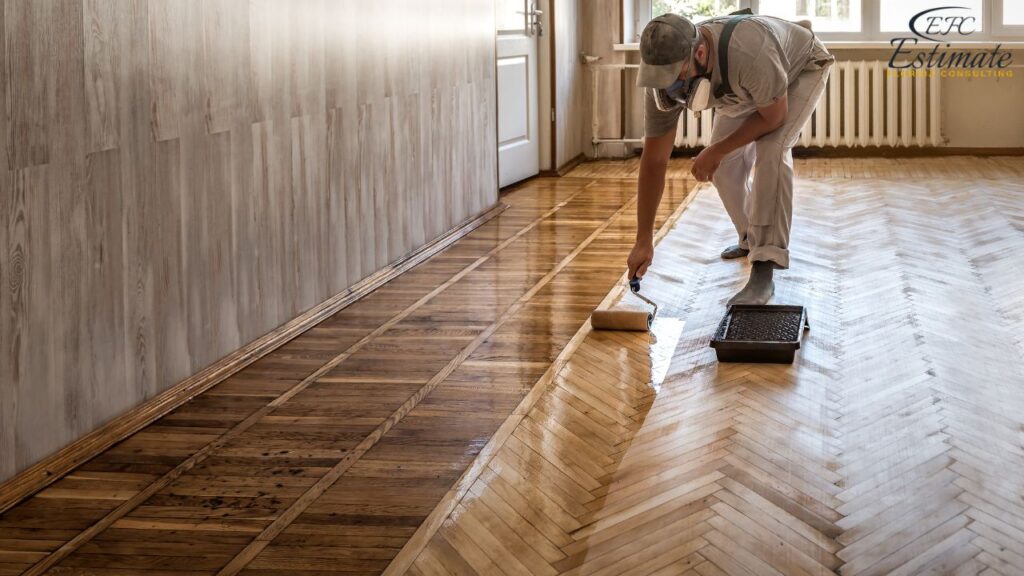
Finishing Treatments:
Finishing treatments such as staining, sealing, and applying a protective coat are important steps in completing your wooden flooring project. These treatments enhance the natural beauty of the wood, protect it from damage, and extend its lifespan. The cost of finishing treatments can range from $1.30 to $3.90 per square foot, depending on the type of finish and the condition of the wood. Investing in high-quality finishing treatments ensures that your wooden floors not only look beautiful but also withstand daily wear and tear, providing a durable and low-maintenance surface that will last for years.
Estimating the Total Cost: Example for a 500 Sq.Ft. Space
To provide a clearer understanding of what to expect, here’s an example of estimating the cost for installing oak hardwood flooring with professional installation in a 500-square-foot area. This estimate includes the cost of the wood, professional installation, subfloor preparation, moisture barrier, and finishing treatments, offering a comprehensive view of the potential expenses involved in your project.
- Oak Hardwood Flooring: $5.20 – $10.40 per sq.ft.
- Professional Installation: $3.90 – $7.80 per sq.ft.
- Subfloor Preparation (if needed): $1.30 – $3.90 per sq.ft.
- Moisture Barrier (if needed): $0.65 – $1.95 per sq.ft.
- Finishing Treatments: $1.30 – $3.90 per sq.ft.
Cost Component | Low Estimate | High Estimate |
Oak Hardwood Flooring | $2,600 | $5,200 |
Installation | $1,950 | $3,900 |
Subfloor Preparation | $650 | $1,950 |
Moisture Barrier | $325 | $975 |
Finishing Treatments | $650 | $1,950 |
Total Estimated Cost | $6,175 | $13,975 |
This example demonstrates how different components contribute to the overall cost of your wooden flooring installation. By breaking down the costs, you gain a better understanding of where your money is going, which helps you make informed decisions and adjustments as needed to stay within your budget. Understanding the potential costs involved allows you to plan effectively, ensuring that you allocate enough resources to cover the entire project while achieving the best possible outcome for your space.
Making the Right Choice
Selecting the right wooden flooring for your home involves more than just considering costs. It’s about finding the perfect balance between quality, durability, and aesthetic appeal.
With various options available—each suited to different environments and needs—it’s essential to weigh the pros and cons of each type to ensure you’re making the best decision for your specific project.
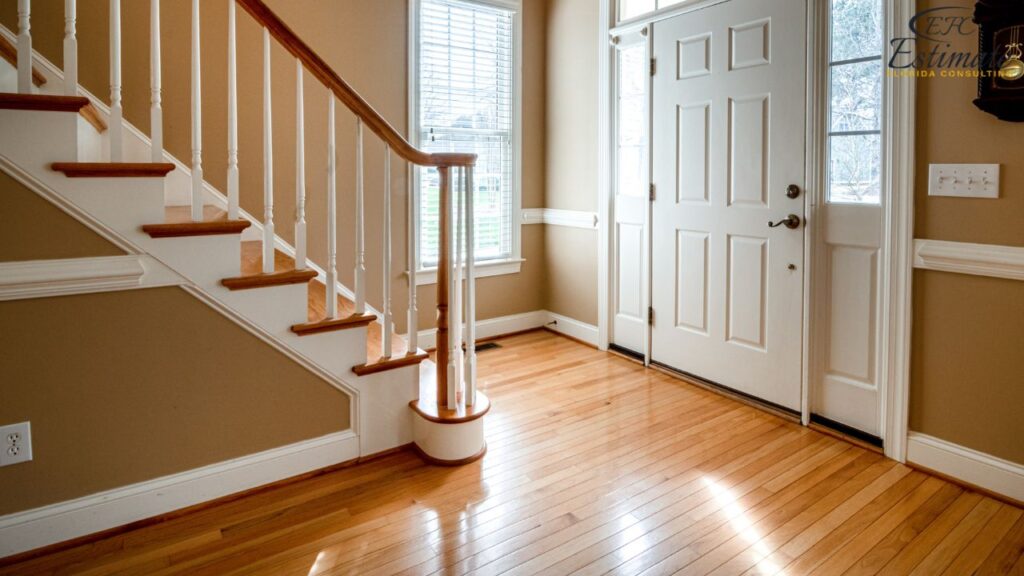
Oak vs. Maple:
Choosing between oak and maple hardwood flooring depends on your specific needs, preferences, and budget. Both types of wood offer distinct advantages, but they also have unique characteristics that may make one more suitable for your space than the other.
Oak Flooring:
Oak is a versatile and durable wood that works well in a variety of settings. It has a prominent grain pattern that adds character and warmth to any room. Oak is also relatively easy to work with, making it a popular choice for DIY projects. Its durability and affordability make it an excellent option for high-traffic areas like living rooms, hallways, and kitchens. Oak’s ability to blend seamlessly with different interior styles makes it a timeless choice for homeowners.
Maple Flooring:
Maple offers a clean, smooth appearance with a subtle grain pattern, making it ideal for modern and contemporary interiors. It is harder than oak, providing better resistance to scratches and dents. Maple’s light color and uniform texture create a sleek and sophisticated look that can brighten up any space. While maple is more expensive than oak, its durability and refined appearance make it a worthwhile investment for spaces where a modern aesthetic is desired.
Solid vs. Engineered Hardwood:
When choosing wooden flooring, you’ll also need to decide between solid hardwood and engineered hardwood. Each type has its own advantages and considerations, depending on your specific needs and the environment where it will be installed.
Solid Hardwood:
Solid hardwood is made from a single piece of wood and offers the most authentic and traditional look. It can be sanded and refinished multiple times, allowing you to restore its original beauty over the years. Solid hardwood is ideal for living areas, bedrooms, and spaces where moisture is not a concern. However, it may not be suitable for basements or other areas with high humidity, as it can warp or expand with changes in moisture levels.
Engineered Hardwood:
Engineered hardwood consists of a top layer of real wood over a plywood or high-density fiberboard (HDF) core. This construction makes it more stable and resistant to moisture than solid hardwood, making it suitable for basements, kitchens, and bathrooms. Engineered hardwood can also be installed over concrete or radiant heating systems, offering greater flexibility in installation. While it may be less expensive than solid hardwood, engineered hardwood typically cannot be sanded and refinished as many times, so its lifespan may be shorter.
Get Acquainted with Wooden Flooring
Long-Term Considerations:
When investing in wooden flooring, it’s important to consider the long-term aspects of your choice. Durability, maintenance, and the ability to refinish the floors will all affect the lifespan and ongoing costs associated with your flooring.
Durability
The durability of your wooden flooring depends on the type of wood, the quality of the installation, and the care it receives over time. Harder woods like oak, maple, and hickory are more resistant to scratches and dents, making them ideal for high-traffic areas. Regular maintenance, such as sweeping, vacuuming, and using area rugs in high-traffic zones, can help protect your floors and extend their lifespan.
Maintenance
Wooden flooring is relatively easy to maintain, but it does require regular care to keep it looking its best. Regular cleaning with a broom, vacuum, or damp mop is usually sufficient to remove dirt and dust. It’s also important to protect your floors from moisture by wiping up spills immediately and using protective pads under furniture to prevent scratches. Depending on the finish of your wood floors, you may also need to apply a protective coat every few years to maintain their luster and protect them from wear.
Enhancing Your Wooden Flooring with Additional Features
Wooden flooring is versatile and can be customized with various treatments and finishes to enhance its appearance and durability. Whether you need additional protection, improved aesthetics, or specific features, there are options available to tailor your wooden flooring to meet your exact needs.
Staining:
Staining your wooden floors allows you to achieve the perfect color to match your interior design. Whether you prefer a light, natural finish or a rich, dark hue, staining can enhance the natural beauty of the wood and give your floors a custom look. The cost of staining varies depending on the type of wood and the color you choose, but it typically ranges from $1.30 to $3.90 per square foot. Staining is an excellent way to personalize your wooden floors and create a cohesive look throughout your home.
Sealing and Finishing:
Applying a sealant or finish to your wooden floors provides a protective layer that helps prevent scratches, stains, and moisture damage. This treatment not only enhances the durability of your floors but also adds a subtle sheen that can make the wood grain stand out. Sealing and finishing treatments typically cost between $1.30 and $3.90 per square foot, depending on the type of finish you choose. Investing in high-quality finishing treatments ensures that your wooden floors will continue to look beautiful and perform well for years to come.
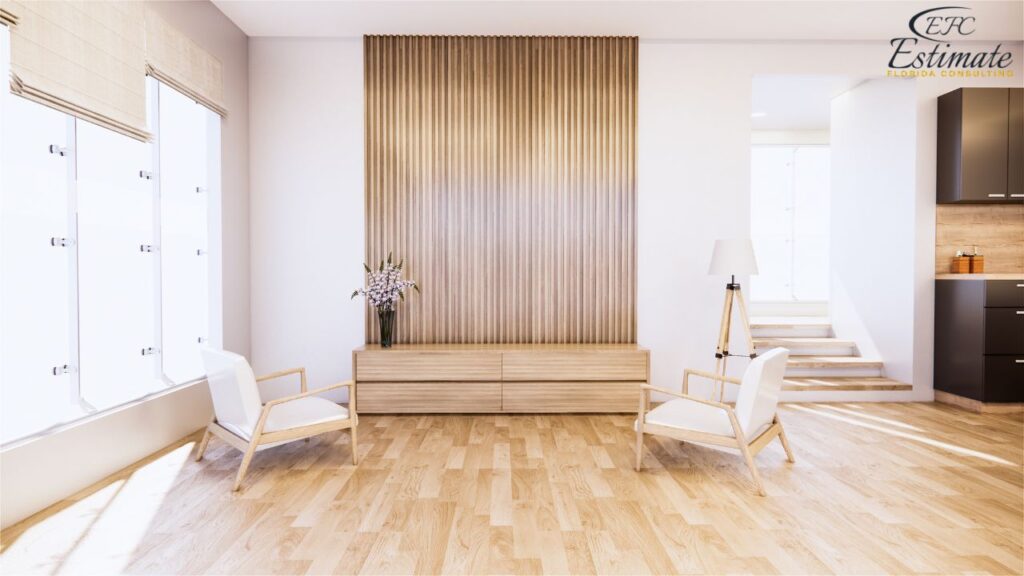
Refinishing:
Over time, even the most well-maintained wooden floors may start to show signs of wear. Refinishing your hardwood floors involves sanding down the surface to remove scratches, dents, and imperfections, followed by staining and sealing to restore their original beauty. The cost of refinishing typically ranges from $3.90 to $7.80 per square foot, making it a cost-effective way to rejuvenate your floors without the need for a full replacement. Refinishing is a great option for homeowners who want to refresh their wooden floors and extend their lifespan.
Common Mistakes to Avoid When Estimating Wooden Flooring Costs
Avoiding common mistakes in estimating the cost of wooden flooring can save time, money, and frustration. Here’s an in-depth look at three key pitfalls to watch out for:
Underestimating Waste:
One of the most common errors when estimating the cost of wooden flooring is underestimating the amount of waste that will occur during installation. Flooring projects inevitably involve cuts, adjustments, and trims to fit the specific layout of your space, especially in rooms with irregular shapes, angles, or multiple obstacles like doorways and vents. Failing to account for these factors can leave you short on materials, causing delays as you wait for additional planks to be delivered. This not only disrupts your project timeline but can also increase costs significantly, especially if the wood is in limited supply or if prices fluctuate. To avoid this, it’s standard practice to purchase an extra 5-10% of flooring materials above the total square footage measured. This “waste factor” ensures that you have enough material to cover mistakes, defects, or last-minute changes in design. Properly planning for waste upfront allows for a smoother installation process and helps keep your project on track and within budget.
Choosing the Wrong Wood for Your Climate:
Another critical mistake is selecting a type of wood that is not well-suited to your specific climate conditions. Wood is a natural material that reacts to changes in temperature and humidity by expanding or contracting. In environments with high humidity or drastic temperature fluctuations, certain woods can warp, buckle, or develop gaps over time. For instance, solid hardwoods are more prone to movement in response to moisture compared to engineered wood, which is designed to be more stable in variable conditions. Choosing the wrong type of wood for your climate can lead to costly flooring repairs, flooring replacements, or even complete flooring failures. To mitigate this risk, it’s essential to research how different woods perform in your climate and consult with flooring professionals who understand local conditions.
Ignoring Subfloor Issues:
Overlooking subfloor preparation is a common oversight that can lead to serious problems down the line. The subfloor serves as the foundation for your wooden flooring, and its condition directly impacts the longevity and performance of the new flooring. If the subfloor is uneven, damaged, or has moisture issues, these problems will likely transfer to the finished surface, resulting in creaks, warping, or even visible defects. Installing new wooden flooring over an imperfect subfloor can cause the wood planks to loosen, separate, or wear unevenly, compromising both aesthetics and structural integrity. Before installation, it is crucial to thoroughly inspect the subfloor and address any issues, such as leveling uneven areas, repairing cracks, or installing a moisture barrier if necessary.
Tips for Maximizing Value from Your Wooden Flooring Investment
Maximizing the value of your wooden flooring investment involves careful consideration of style, quality, and long-term planning. Here are some in-depth tips to help you get the most out of your flooring choice:
Choose Timeless Styles:
Opting for timeless wood types and finishes is one of the most effective ways to ensure your flooring remains stylish and valuable over time. Classic choices such as oak, maple, and walnut have stood the test of time due to their versatility and enduring appeal. These woods not only blend seamlessly with a wide range of interior design styles—from traditional to modern—but they also tend to be preferred by homebuyers, which can be a significant advantage if you plan to sell your property in the future. Neutral finishes like natural, honey, or light stains can further enhance the timeless quality of your floors, allowing them to complement various color schemes and decor trends. By choosing styles that are not overly trendy or specific to a particular design era, you can avoid the need for frequent updates and maintain a cohesive look throughout your home.
Download Template For Wooden Flooring Project Breakdown
- Materials list updated to the zip code
- Fast delivery
- Data base of general contractors and sub-contractors
- Local estimators
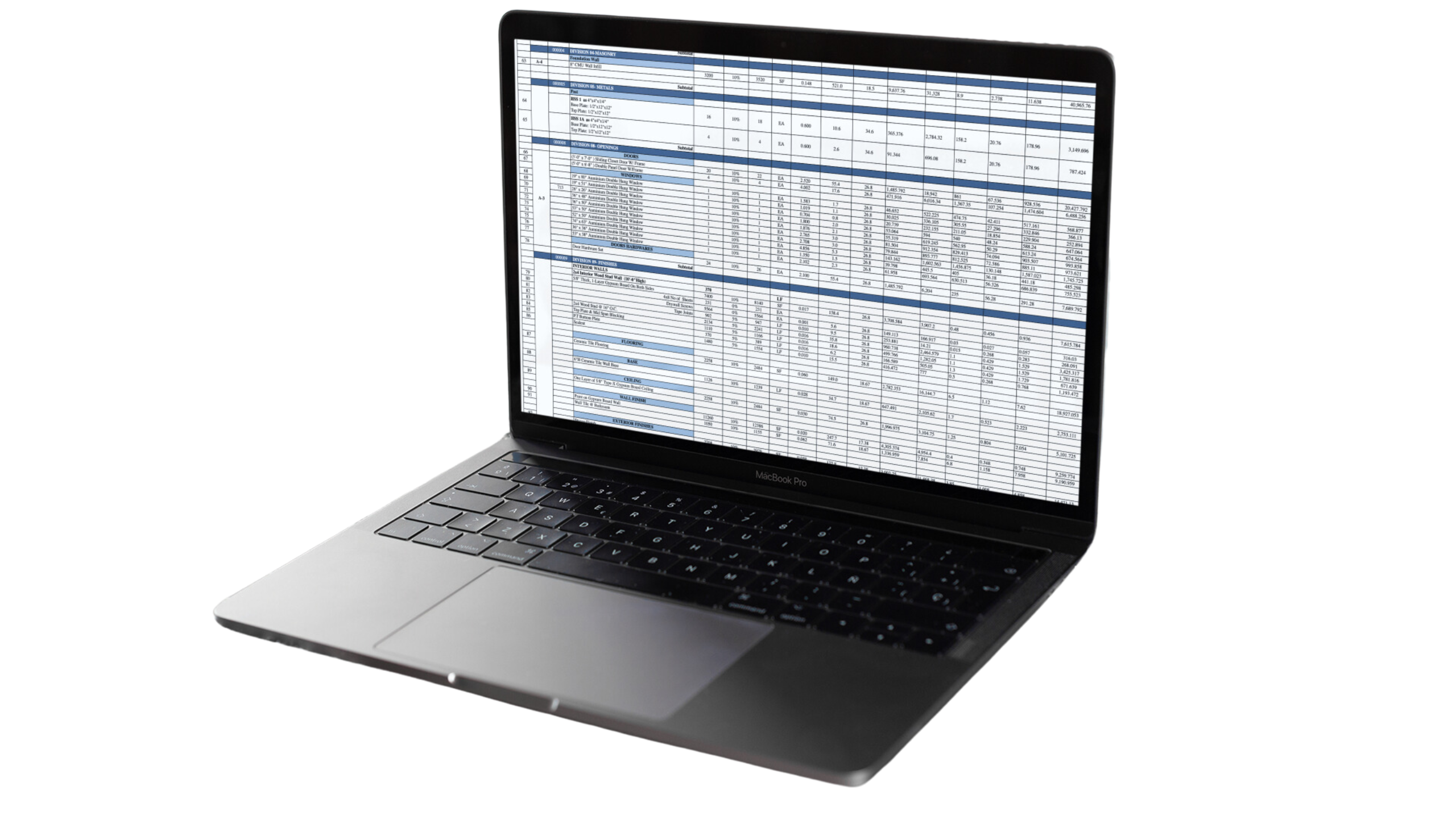
Quality Over Cost:
While it’s tempting to minimize expenses by opting for cheaper materials and installation services, this approach can often lead to higher costs in the long run. High-quality wooden flooring is an investment in both durability and aesthetics. Superior woods like select or clear grades have fewer knots and blemishes, providing a more uniform appearance that appeals to discerning buyers and can withstand daily wear and tear more effectively. Additionally, professional installation is crucial for achieving a flawless finish and ensuring that the flooring performs as expected. Skilled installers understand the nuances of wood movement, proper acclimation, and the best installation techniques, which can prevent common issues like gaps, buckling, or squeaks.
Plan for the Future:
When selecting wooden flooring, it’s important to think beyond your immediate needs and consider how your choice will fit with future changes in your home. As your tastes, lifestyle, or family size evolves, your flooring should be versatile enough to accommodate these changes without necessitating a costly replacement. For example, if you plan to remodel or change the interior design of your home, neutral-toned and versatile wood can easily blend with different styles and color palettes. Similarly, if you anticipate high foot traffic, pets, or the possibility of needing wheelchair accessibility in the future, selecting a durable wood species with a hard finish can prevent wear and damage.
Conclusion
Wooden flooring is a timeless and elegant choice that can enhance the beauty and value of your home. By carefully considering the types of wood available, the costs involved, and the specific needs of your space, you can make an informed decision that will provide long-term value and satisfaction. Whether you opt for oak, maple, or another wood type, understanding the full scope of your project ensures that you choose the best possible solution for your flooring needs. With the right planning and execution, wooden flooring can transform your space, offering a blend of durability, beauty, and style that is unmatched by other flooring options.
FAQs
The cost of wooden flooring installation is influenced by several factors, including the type of wood, the grade and quality of the material, the complexity of the installation process, and any additional treatments or finishes. The condition of the subfloor, the need for moisture barriers, and whether you choose DIY or professional installation also play significant roles in determining the overall cost.
The cost of wooden flooring varies based on the type of wood:
- Oak: $5.20 – $10.40 per sq.ft.
- Maple: $6.50 – $13.00 per sq.ft.
- Cherry: $7.80 – $15.60 per sq.ft.
- Walnut: $8.45 – $16.90 per sq.ft.
- Hickory: $7.15 – $14.30 per sq.ft.
- Bamboo: $4.55 – $9.10 per sq.ft.
The total cost will also include installation fees, which range from $1.95 to $7.80 per sq.ft., depending on whether you opt for DIY or professional installation.
Wooden flooring offers several key benefits:
- Timeless Appeal: Hardwood floors add warmth, character, and elegance to any room.
- Durability: Hardwood floors are long-lasting and can withstand heavy foot traffic.
- Easy Maintenance: Simple cleaning routines keep hardwood floors looking pristine.
- Increased Home Value: Hardwood floors are a desirable feature that can boost your home’s market value.
- Eco-Friendly Options: Many hardwood floors are sourced from sustainably managed forests.
The grade of wood affects its appearance and cost:
- Clear Grade: $8.45 – $16.90 per sq.ft. (Highest grade, minimal imperfections)
- Select Grade: $6.50 – $13.00 per sq.ft. (Slight variations, fewer imperfections)
- Common Grade: $5.20 – $10.40 per sq.ft. (More natural variations, affordable)
- Rustic Grade: $4.55 – $9.10 per sq.ft. (Significant variations, most affordable)
- DIY Installation: $1.95 – $4.55 per sq.ft. Suitable for those with experience and the necessary tools. It can save money but requires precision and time.
- Professional Installation: $3.90 – $7.80 per sq.ft. Ideal for ensuring a flawless finish and handling complex projects. While more expensive upfront, it guarantees quality results and can prevent costly mistakes.
- Subfloor Preparation: $1.30 – $3.90 per sq.ft. (Ensures a smooth installation)
- Moisture Barrier Installation: $0.65 – $1.95 per sq.ft. (Prevents water damage)
- Finishing Treatments: $1.30 – $3.90 per sq.ft. (Enhances durability and appearance)
- Oak: Versatile, durable, and has a prominent grain pattern. Suitable for high-traffic areas and various interior styles.
- Maple: Harder than oak, with a smooth, subtle grain. Ideal for modern interiors and areas where a sleek, clean look is desired.
- Solid Hardwood: Made from a single piece of wood, can be refinished multiple times, ideal for living areas and bedrooms. Not suitable for high-moisture areas.
- Engineered Hardwood: Has a real wood top layer over a plywood or HDF core, more stable and moisture-resistant, suitable for basements, kitchens, and bathrooms.
To estimate the total cost, multiply the square footage of your space by the cost per square foot for the wood, installation, subfloor preparation, moisture barrier, and finishing treatments. For example, installing oak hardwood flooring with professional installation in a 500 sq.ft. area might cost between $6,175 and $13,975.
A professional estimate provides a clear understanding of the total costs involved, ensuring that all aspects of the project are accurately scoped. This helps avoid unexpected expenses and ensures that your project stays on track both financially and in terms of timing.
Google Reviews

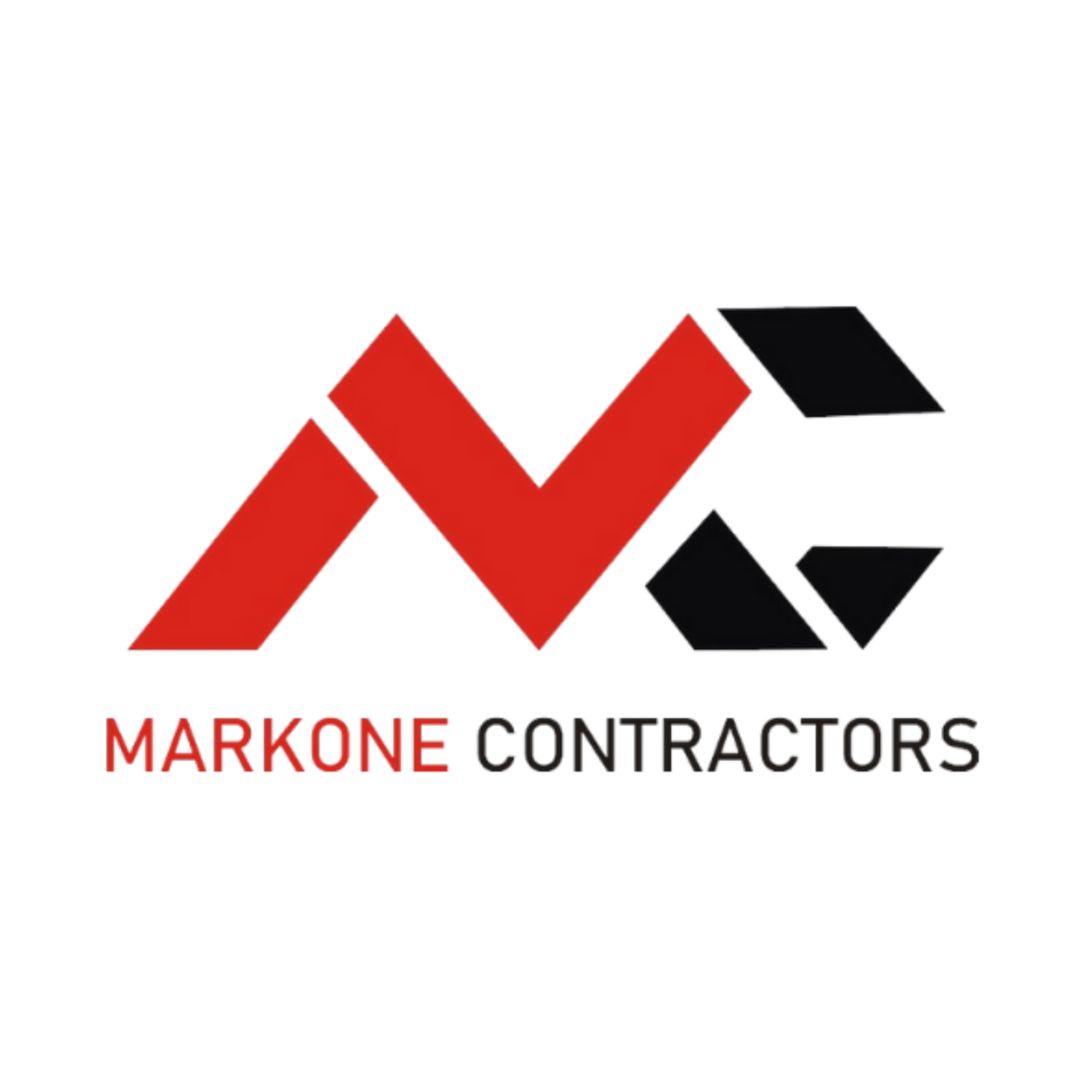

Process To Get Wooden Flooring Cost Estimate Report
Here I am going to share some steps to get wooden flooring cost estimate report.
-
You need to send your plan to us.
You can send us your plan on info@estimatorflorida.com
-
You receive a quote for your project.
Before starting your project, we send you a quote for your service. That quote will have detailed information about your project. Here you will get information about the size, difficulty, complexity and bid date when determining pricing.
-
Get Estimate Report
Our team will takeoff and estimate your project. When we deliver you’ll receive a PDF and an Excel file of your estimate. We can also offer construction lead generation services for the jobs you’d like to pursue further.

